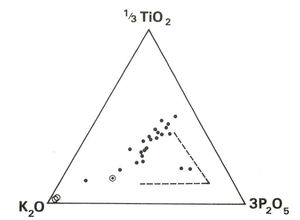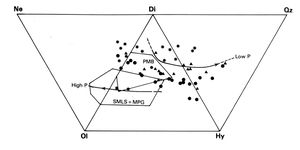Minor intrusions - geochemistry - St. Kilda: an illustrated account of the geology
| From: Harding, R.R. and Nancarrow, P.H.A. 1984. St. Kilda: an illustrated account of the geology. BGS Report Vol. 16, No. 7. Keyworth: British Geological Survey.]. |



Chapter 16 Minor intrusions. Geochemistry
Keywords: chemical analysis, magma mixing and differentiation
Chemical analyses of 24 minor intrusive rocks from St Kilda were carried out; 16, representing the range, are given in (Table 29). A chemical classification of the rocks is based on the scheme of Irvine and Baragar (1971) and uses normative values recalculated after the manner of Thompson and others (1972) in which the values for Fe2O3 are adjusted to 1.5% or 2% depending on the alkali content of the rock. This scheme shows that a range of basaltic compositions is present, with most being classified as olivine + hypersthene normative tholeiites and only a small number being quartz normative. Only a few sheets are strongly quartz normative basaltic andesite, although one cuts the Mullach Sgar Complex at the northern end of Na h-Eagan [NM 0937 9850], and is comparable with some mafic pillows (Phase 3) within the Mullach Sgar Complex itself. The composition of the inclined sheet is probably a mixture of basaltic magma and granitic or sedimentary material as a partially resorbed quartz xenocryst can be seen in thin section. Cockburn (1935) recorded partially resorbed quartz crystals in another inclined sheet below Mullach Bi (Figure 27B). Some olivine + hypersthene normative basalts fall in the alkaline field of a Ne′Ol′Q′ triangular diagram (Irvine and Baragar, 1971) and the compositions of two late sheets are nepheline normative. The analysis of one marked R in (Figure 24B), is given in (Table 29), col. 7, and the other, which cuts the granite on Oiseval, appears in col. 8.
The range of normative values is shown in (Figure 29), and this distribution of the compositions is consistent with that of a series of rocks which have undergone fractionation at low pressure, suggesting that the St Kilda rocks were derived from a high level magma chamber. These were possibly developed within the continental basement since crustal contamination of the basalts can be demonstrated on a TiO2Template:Anchor –K2O–P2O5 diagram (Figure 28). The St Kildan basalts become increasingly potassic at a fairly constant ratio of Ti:P and follow a similar trend to basalts from Ardnamurchan which only differ in lying closer to the P2O5 apex. Thompson (1982a) has demonstrated that such enrichment in potash in the Ardnamurchan cone sheets cannot be due to closed system fractionation and is therefore due to contamination by sialic crust. However two rocks, one from a sheet cutting gabbro at Ruaival, the other from a sheet cutting gabbro at An Fhaing, Dun, are enriched in phosphorus and lie close to the trend for closed system fractionation. High values for other trace elements in these two rocks with corresponding low values for Ni and Cr are a further indication that fractionation has occurred. Geochemically the basic minor intrusives are similar to basalts from other Tertiary centres in that they possess low trace element abundances relative to typical continental tholeiitic rocks, but differ in respect of the proportions of these trace elements. In addition to differences in Ti–K–P proportions noted above, the St Kildan rocks have higher yttrium : zirconium ratios (0.15–0.27) than most basalts in the British Tertiary Volcanic Province, these ratios being exceeded only in sheets cutting the submarine Blackstones igneous complex WSW of Mull (Durant, unpublished data).
Analyses of both basic and acid components of two composite dykes are given in columns 13–16 of (Table 29). In both intrusions the outer part is basaltic and the inner is granitic. Both granitic components differ petrographically but have a similar SiO2 content of 72%, which, along' with Ca, Mg and Fe values, lies between those for the Glen Bay Granite (69%) and the Conachair Granite (76%).
References
| At all times follow: The Scottish Access Codeand Code of conduct for geological field work |